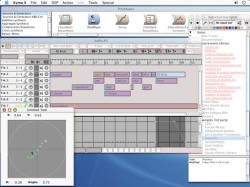
Symbolic Sound has introduced Kyma X.82, a software update for the Kyma X/Pacarana sound synthesis engine, designed to take advantage of the expressive capabilities and extended control offered by today’s new crop of alternative controllers and cutting edge musical interface designs.
The recent explosion of interest in new musical interfaces and alternative controllers for sound design and music has created a need for sound synthesis and processing engines that can take full advantage of the increased bandwidths, higher resolution, lower latencies, continuous pitch and velocity values, and subtle expressive capabilities of these new controllers. Kyma X.82, introduces several additional features to support these innovative musical interfaces and alternative controllers.
Features in Kyma X.82 include:
- over 20 new morphing sound synthesis algorithms;
- support for 14-bit MIDI controllers; and
- the publication of Kyma’s OSC protocol to support and inspire future developments of new instruments and controllers that can exploit Kyma’s high-resolution sound synthesis and processing algorithms in a plug-and-play manner.
Additional features of the new release include enhanced multichannel panning and effects, higher quality spectral analysis, and a 40% speedup in the software executing on the host computer.
http://www.youtube.com/watch?v=nt9tXXaXRrM
Here’s a video demo with Kyma X.82, demonstrating one of the new Morph3d objects to morph among a re-synthesized Tuva singer, bongo, flute, angry cat, female voice, violin, cat meow, and shakuhachi using Kyma Control on an iPad.
This video demonstrates a key-mapped flute spectrum is re-synthesized with a time-stretched attack and played on the Tonnetz in Kyma Control.
Here are audio demos made with Kyma X.82:
Highlights of Kyma X.82:
- Sound and Timeline download times have been slashed in half (on top of a 20% speed-up in user interface and downloading made earlier this year adding up to 120% increase in overall speed since last year at this time).
- Support for 14-bit MIDI controllers, both big endian and little endian
- Support for polyphonic aftertouch
- Increased number of voices for voice-stealing (up to 128 simultaneous key-downs in a 5 ms interval)
- Merging for up to four USB MIDI input devices connected to the Paca(rana) USB ports
- New synthesis algorithms including:
- InterpolateN: a linear or constant power crossfade through any number of inputs
- MultiSampleCloud: granular processing of samples with live switching between sample files
- New family of algorithms for morphing in 1d, 2d, and 3d timbre spaces using 7 different resynthesis techniques: SampleCloud, Psi, OscillatorBank, FilterBank, FormantBank, CloudBank, and GA (group additive)
- Tool for batch analysis (Psi, spectral, and GA)
- 2d faders both in the virtual control surface and in the Kyma Control iPad app
- Display score and other instructions to performers on the Kyma virtual control surface as .png images.
- Other virtual control surface enhancements include buttons with different labels for on/off states, resizing to fit iPad, and other resizing/fitting tools.
- More multichannel panning and processing in real time (due to increased efficiency of the multichannel algorithms)
- Improved dynamic range in the spectral analyses. The SNR of spectral analysis has been increased by 48 dB on the Paca(rana) and the GA (group additive) analysis has been improved by 48 dB on the Capybara and 96 dB on the Paca(rana).
- Timelines with WaitUntils for live performance can now be recorded to disk. Additional Timeline enhancements include: Track renaming, deleting, inserting, and reordering
- Smalltalk and CapyTalk code assistance in the form of syntax coloring; colors and type face in the parameter fields help organize code and indicate syntax errors
- New data sonification tools
- Publication of the Kyma OSC protocol for third-party musical interface developers
- Kyma X also works under the Apple Lion operating system for Macintosh.
Third-party Developers
A batch analysis tool included in the release enables Kyma users to create custom Analysis File libraries, giving their own signature sound to the new synthesis algorithms in Kyma X.82.
Publication of the Kyma OSC protocol means that third-party developers can create software interfaces, alternative controllers, and new musical instruments that can take advantage of Kyma’s rich library of expressive, responsive algorithms and renowned audio quality. The protocol includes two-way communication of note events, controllers, and graphical control surface layouts over TCP/IP networks (such as Ethernet, Wi-fi, or the Internet):
Kyma X.82 is immediately available as a free download for registered Kyma X users.
